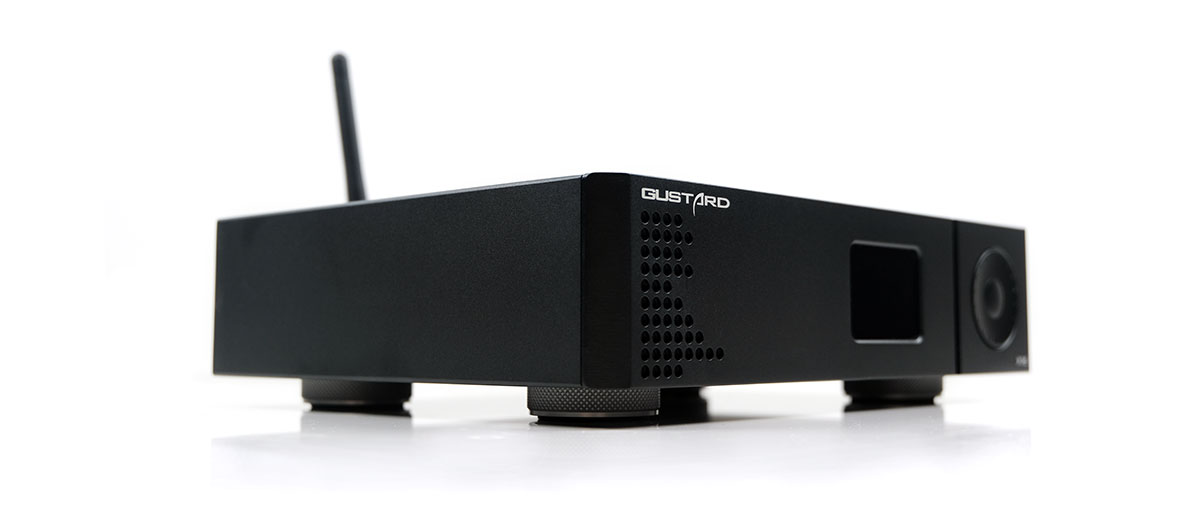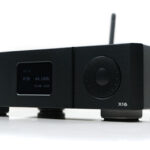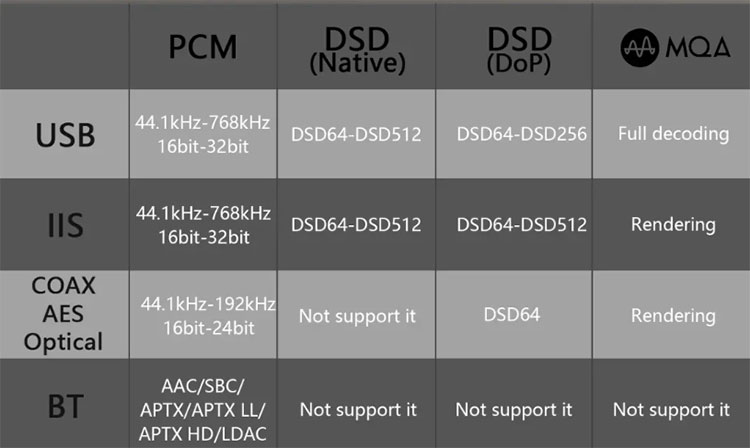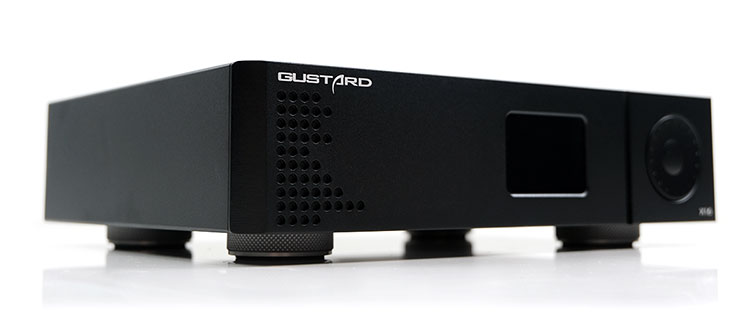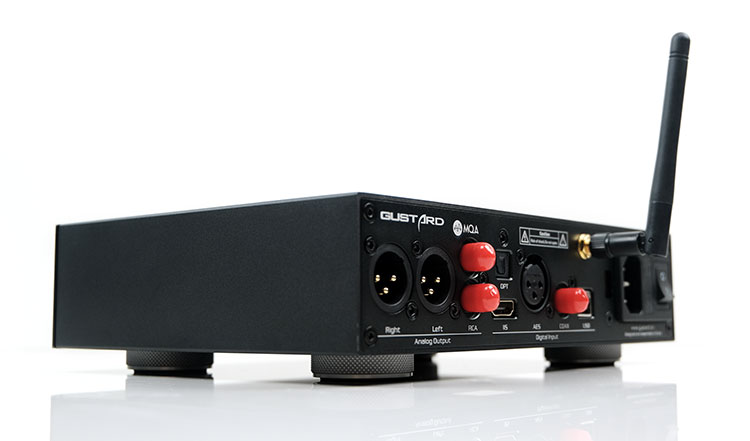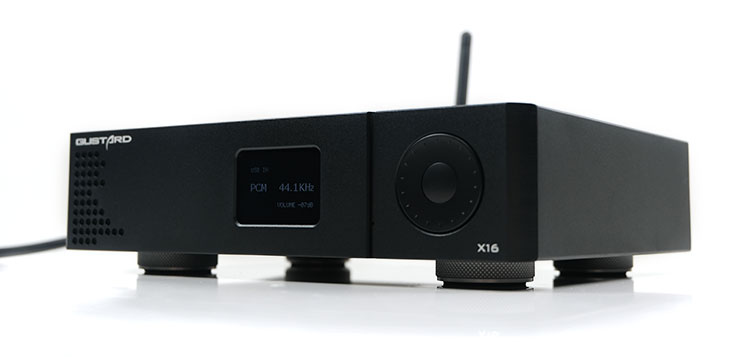The Gustard X16 is a desktop DAC featuring a dual ES9068AS chipset, decoding up to DSD512, PCM 32BIT/768kHz, and offering BT LDAC capability. It is priced at $499.99
Disclaimer: The Gustard X16 was sent to us as a sample in exchange for our honest opinion in this review. We thank Aoshida Audio and Gustard for this opportunity.
To learn more about DAC reviews on Headfonics you can click here.
Note, this 2-page review follows our new scoring guidelines for 2021 which you can read up on here.
Gustard is one of those names that has a strong pull in the audiophile sector down through the years. Curiously, it is also a brand that has alluded us in terms of review work so their new DAC-X16 marks the debut of the brand on our website.
Gustard is actually a registered trademark owned by Shenzhen Geshide Electronics Co., Ltd., a broad-based electrical appliance company based in Shenzhen.
They have been around for a while now and are known for their desktop audio solutions, with a particular focus on headphones. This primarily includes headphone amplifiers, DACs, as well as clocks, and more recently integrated streaming devices.
Our sample here today is the DAC-X16 or X16 which I believe is their most affordable pure DAC at $499.99 placing it firmly in the mid-fi DAC market which has been very competitive of late.
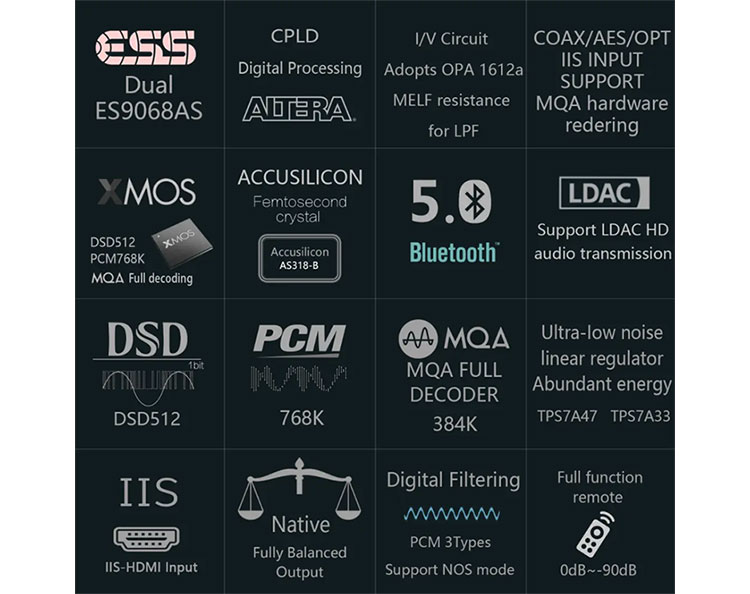
Tech Highlights
The Gustard X16 is a compact balanced desktop DAC with a pre-amplifier and wireless capability. Now with the picture above, there seems to be a lot to talk about but I wanted to just focus first on the DAC implementation because there are some important features in there.
DAC
The X16 is the first DAC from Gustard to feature a dual 32BIT 2-channel ES9068AS chipset, (balanced). This particular chip was launched in 2019 by ESS and is seen as a functional upgrade to the ES9028/38Q2M mobile chipset solutions.
This is also one of the first DAC solutions to feature onboard MQA decoding up to 384k negating the need for separate modular implementations for both decoding PCM/DSD and native MQA unfolding/rendering.
The rendering is the critical aspect of the ES9068AS functionality. Before DAC MQA solutions typically depended on fine-tuning using the DAC output filters, this process is now automated inside the chipset.
The ES9068Q will automatically detect the MQA stream and engage the rendering so the entire process requires no additional design work by Gustard. That includes MQA via USB, as well as SPDIF and I²S further reducing the need for individual identification and control implementations in the signal path.
Decoding
Of course, not everyone wants or uses MQA so the X16 also comes equipped with an XMOS XU216 USB interface capable of receiving up to DSD512 and 32BIT/768kHz PCM decoding which, aside from a few high-end R2R solutions, is about as high as it gets for most mainstream affordable DACs.
Aside from USB decoding, the X16 also offers I²S decoding, also up to DSD512 and PCM 768kHz and SPDIF up to DSD64 over DoP and PCM 24BIT/192Khz. Note that USB does the full MQA decoding sequence, with IIS and SPDIF rendering only.
The X16 also includes an option to control oversampling with NOS built into the menu system as well as 3 different types of digital filters.
Clock management pre-DAC is done via an Altera Max II instant-on, non-volatile CPLD, or a programmable logic chip similar to FPGA though slightly less complex. The Altera MAX II is also supported by a dual Accusilicon Femtosecond Crystal Oscillator for jitter control.
Bluetooth
As is all the rage these days with DACs, the X16 comes with Bluetooth 5.0 streaming capability via an internal Qualcomm CSR8675 chipset. The X16 is set up as a receiver, with no transmitting capability but can decode from SBC up to aptX and LDAC 24BIT audio from various sources such as your smartphone or DAP.
Pre-amp
The X16 can be operated in a fixed voltage or variable voltage output with both balanced and single-ended pre-amp capability. Going SE you get an industry-standard 2Vrms output which should match well with most single-ended analog amplifier inputs.
Balanced will allow for 4Vrms which is ok but not to the level of the Cayin iDAC-6 MK2, for example, which has a capability of up to 7V unbalanced and 13V balanced. Thus, the X16 may not be the most suitable for demanding power amps that like stronger output voltages from their preamps.
Performance numbers do look very impressive actually though with a dynamic range of up to 126dB. Considering the ES9068AS is rated at 128dB that’s a strong effort from Gustard in terms of noise reduction through the signal path, (THD+N: <0.00010% ).
Design
Form Factor
The most surprising thing about the X16 design is the size. I was expecting something a lot larger but instead it a very compact device. Not Pro-ject Audio Pre-Box S2 Digital compact but certainly a lot smaller than a Gungnir or a SU-9.
The precise measurements are 22 x 5 x 17cm so quite a petite and stackable device. It is also designed to be stacked with its equally compact companion, the H16 headphone amp, and most likely the C18 Master Clock since they both have the same dimensions. Having said that a master clock at $1599 might be a bit of overkill for a $499 DAC.
Do not let that cute size fool you though in terms of robustness. This is no hollow shell with a very solid chassis and a toroidal linear PSU coil inside weighing in at 2.5Kg. Those wide-body rubber-finished columns for feet should give you a hint that the X16 is not as light as you think.
Finishing
The overall design is more utilitarian than exotic with two flavors, anodized black, and silver. Both have a rectangular aluminum finished housing with just enough smoothing on the corners and edges to allow for easy handling.
The X16 finishing is accented with Gustard’s signature multi-circle machining to the left under their logo and a grooved partition-like line to the right just before the multi-function volume dial. All inputs and outputs are housed on the rear panel.
The plastic volume dial is quite low-profile and quite flush with the chassis with a sort of dish-like shape. However, is grippy with plenty of little ridges towards the edge so it is easy enough to manipulate. The center of the dial is the function button for menu operation so together they form a multifunction control system for both preamp volume control and menu operation.
The X16 also has a small white light OLED screen for a digital readout of the unit status. It is quite clear and easy to read as well though you do have the option to dim the display or turn it off from the units menu system.
I/O
All digital and analog I/O is housed on the rear panel of the X16 with a wide selection of modern connectivity sockets. That includes both balanced and single-ended 3-pin XLR and RCA outputs for the analog output and optical, coaxial, and USB for your traditional digital inputs.
The X16 also has an additional input for I²S compatible devices such as WiFi streaming devices as well as an AES 3-pin XLR input socket. The last socket is for the BT antenna beside the PSU. This does extend the overall dimension of the unit by a few centimeters when in its upright position. It is rotational, however, so you can lower it slightly in either direction.
Controls
You can control the X16 in two different ways, via a supplied remote control and manually from the multi-function dial on the unit itself. All tweakable options are pulled up on the OLED display including decoding rate, input stage, and volume levels if using the X16 as a preamp.
The menu system itself offers 5 options to adjust including 3 PCM filters, NOS or Non-NOS mode, always on BT if you prefer, and a phase invert option. You have two environmental controls, the first of which is a timed auto-off for the display selector and the second the overall brightness of the screen itself.
Remote Control
You can of course switch to the remote control which I believe is a common control for the X16, the H16, and a streamer option which I presume to be the U16.
Basically, the 16 series stacked on top with the ability to switch between them by pressing a DAC, amp, or streamer button at the bottom of the remote control. If you have just one unit, such as the X16, then these buttons are largely redundant.
All other options can be accessed via the remote control including the menu heads up including menu navigation/selection, (directional and play style button pad), as well as volume control. You can also switch between your input options with the navigational up button without having to directly access the menu.
Wireless Performance
Pairing
Pairing with the Gustard X16 is very straightforward for both mobile and desktop sources. Simply ensure the X16 BT option is selected or set to always on in the menu and it should pop up on any transmitter pairing search. There is no pairing code required to complete the handshake either.
The X16 BT module is multi-point capable with at least a double pairing with both my DAP and smartphone at the same time. I was hoping for the trifecta of a laptop, DAP, and phone but sadly Windows had an issue hooking up with the X16 when it was already paired with either phone or DAP.
Stability & Range
The stability is rock solid up to around 10-12 meters with 1 wall in between which is a little bit better than the Burson Composer Performance 3X BT range and on par with the now discontinued Topping D90 performance.
You can stash your source in the next room beside your main system and you shouldn’t get much in the way of signal dropout, especially if you are using a smartphone or in-house dedicated BT transmitter which I tend to find to have stronger BT antenna implementations inside them compared to DAPs.
Latency
Latency is tight, even when dropping down to aptX on Windows 10, (Acer Nitro 5). Using VLC, I honestly did not feel the need to tweak the audio sync and when I did my usual TWS tweak to 0.2s it actually felt a bit out of whack with the video playback.
With streaming content on aptX Windows 10 such as Netflix, the large was a little bit more noticeable though better than most TWS solutions tested to date. I got much a better performance using the X16 with LDAC from portable sources with both Netflix and YouTube audio and video sync very tight with no noticeable lag.
Packaging & Accessories
Packaging is fairly standard for a unit at this price point with the compact size producing a fairly compact brown box that won’t tax your courier too much. The insides are properly protected with a white foam interior and the unit itself is wrapped in some anti-static wrap. The SE ports on the unit also come with soft silicone covers, red and white.
Inside you get a power cable, the remote control, a 2m USB data cable, a user manual with a warranty card, and the wireless Antenna. If you are using an earlier version of Windows such as 7 or 8 or pre-Creator’s edition of Win 10 then a supplied mini-CD with the appropriate drivers is also included.
Gustard X16 Sound Impressions
(Tested amplifiers included a Monoprice Monolith Liquid Platinum, Bakoon HPA-01, Rupert Neve RNHP, and the Auris Audio HA-2SE).
Summary
The X16 offers a generally neutral character though not what I would term an overly dry sound. With NOS switched off it does bias a little more to a cleaner and more expansive sound but with both options, you do still get an absolutely excellent black background or low noise floor.
However, the propensity for a harsher or typical Sabre glare in the upper mids and lower-treble seems not to be present. This is a performance very much to the refined side with little in the way of an overly energetic or sharp midrange and treble despite its top-end showing some good presence.
The neutrality does extend into the low-end also which is where more aggressive DAC’s such as the Schiit Gungnir seem to be stronger in terms of sheer physicality with our test amps. However, the X16 does carry more weight and warmth than our other test DAC, the Project Audio Pre-Box S2 Digital which uses an ES9038PRO chipset and sounds comparatively thinner.
There is also a bit of a difference in terms of additional refinement from the likes of the Gungnir: swapping physicality for definition, aggression for articulation, and in doing so the X16 managed to create a more complex and coherent presentation.
That, I find to be a strength of newer Sabre chipsets when done correctly over older AKM DACs. You get more slam on an AKM chipset such as the AK4399 with more vocal immediacy. However, for everything else, for example, a harder-edged treble, it can often clash or sound slightly off.
Timbre
The X16 delivers a neutral level of body in instrumental notes throughout with a timbre that is ever so slightly warm to the upper mids, then slightly sweeter and brighter from there into the treble.
You can only really discern this though from comparing with other DACs as the coloration is very nuanced in its own right. Otherwise, the level of transparency from the X16 is very good with each amplifier tested pretty much true to its own unique coloration.
My only caveat is with regard to how much the X16 NOS option influences the final output and there are some pros and cons which we discuss in more detail further down.
With the NOS off, the X16 timbre does have a better odd-harmonic balance in the mids to give it a lift both in terms of presence and in clarity. Particularly with head voice vocals that register higher and need a bit of energy in them to shine.
With NOS on, they start sounding a little more rounded in tone, less distinct also, and slightly further back in the mix.
Staging
Despite its moderate level of physicality and slam, the X16 does wonderfully well in terms of accurate imaging and instrumental separation. The resolution and dynamic range here are very good and almost optimal going balanced without NOS where applicable.
In turn, this helps a lot with clarity on the low-end which does balance out the comparative lack of aggression with superior articulation. Bass positioning is mildly emphasized in terms of staging, but that dynamic range performance keeps it clear, tight, and properly defined right down to 20Hz on our test amps.
Mids to upper-mids are also relatively flat in terms of positioning and not quite as peppy or as forward as some alternative Sabre DACs.
However, the same Sabre DACs can sound top-heavy in their staging bias such as the S2 with sibilance and splashy percussion more to the fore. That is one thing the X16 seems particularly good at, holding unnatural sibilance in check whilst still providing plenty of headroom.
Balanced
Going balanced is preferable though not necessary if you have a very good SE analog amp, (see Synergy section below). Where the amp did offer a choice the X16 balanced output did outperform its SE alternative.
You can pick up on the X16 balanced performance primarily on the technical side with a better dynamic range performance compared to its SE. With the SE there is a comparative increase in compression making the overall tone of our test amp, the Liquid Platinum, a bit more muted or sedate sounding.
The central image remains relatively unchanged when going from SE to balanced on the X16. This is more about the level of separation and the 3-dimensionality of the stage improving considerably.
In SE, various aspects of the performance just shrink a bit more inwards both in terms of spaciousness and physicality. Going balanced, aspects that improve include sub-bass presence and extension, the amount of top-end presence, and how wide those peripheral spatial cues image when they chime in.
NOS
Going back and forth it seems the NOS mode takes a little bit of glare off the top-end compared to the non-NOS mode. In some instances, I can see people preferring the NOS mode if they have a mix of bright or poor recordings or a brighter amp and headphones.
However, I found the timbre a little too rounded for me and perhaps not as vivid and expressive for vocals as the non-NOS mode. Switching off NOS gave a slightly airier tone, a bit more treble shine, and more accuracy in the harmonic balance from our test amp in this instance, the Monoprice Monolith Liquid Platinum.
Click on page 2 below for pairings and select comparisons




